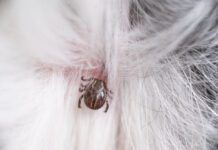By Bliss Foster
Have you ever known exactly what your dog wanted or needed by simply looking into his or her sweet brown eyes? Most of us have experienced this with our dogs. An owner’s insight regarding whether a dog would rather play tug or eat an early dinner may seem relatively unimportant in the greater scheme of things. But for many of us who have a close relationship with our dogs, we may have experienced that intuition on a much deeper level. We can tell, for instance, when our pooch is having an off-day or isn’t feeling well, even if the outward signs might not be visible to anyone else.
Intuition is defined as “quick and ready insight,” and “the power or faculty of attaining to direct knowledge or cognition without evident rational thought and inference.” In other words, you just know. And one of the most important times an owner can utilize intuition on behalf of a pet is at the veterinarian’s office.

According to New Hampshire veterinarian Myrna Milani, an expert in animal ethology who has authored books on the human-animal bond, we are the most important advocates our dogs have when it comes to health. Dr. Milani believes if an owner has intuitive feelings about a pet’s condition and trusts those feelings, it is crucial to act upon them. “It’s coming from a different place,” she says.
Acting on those feelings may simply be a matter of solid communication skills between an owner and a veterinarian. You should count your lucky stars if you have found a veterinarian who truly listens and considers your observations concerning your dog’s physical symptoms, as well as any suspicions or insight about what’s going on. If a pet is ill, there is no greater gift.
Sometimes, though, unanticipated action on an owner’s part may be necessary – like knowing when to ask about other options if a course of treatment does not seem effective. An owner may also be placed in the position of having to ask the right questions or to expound on the background information that has led up to a pet’s health problem.
If communication between an owner and veterinarian breaks down in part or whole, then being true to intuitive feelings may mean seeking a second or even third opinion. “People need to think more about what they feel is best for their animals,” says Dr. Milani.
Act while you can
It’s important to take action when you get a feeling that you should; no one benefits from learning too late that they should have followed their instincts, whether it was to get another opinion or demand a certain test or diagnostic procedure.
This was the sad lesson learned last spring by Martha Turner of North Richland Hills, Texas. Turner decided to spay Blaze, her five-year-old, AKC conformation champion Rottweiler, after Blaze had produced a litter of beautiful puppies in 2003. Turner felt that one litter was enough, and wanted to eliminate the possibility of certain cancer risks in Blaze’s future.
Blaze’s pre-op blood work was fine. Her spay surgery was performed on a Friday by a vet Turner had known for more than 10 years. Turner picked Blaze up from the vet after work, and settled the dog in for a quiet recovery at home.
Late Sunday morning, Turner contacted the vet’s office asking about getting pain medication; Blaze was trembling and seemed very uncomfortable. Per the vet’s instructions, she gave Blaze aspirin and watched her for the remainder of the day. This seemed to help. By Sunday night, though, she was trembling again and Turner detected shortness in Blaze’s breathing.
On Monday, Turner took Blaze back to the clinic. More blood tests were run, which appeared to be normal. Blaze was prescribed an antibiotic and Turner took her back home. By Monday night, Turner heard “what sounded like fluid” as Blaze breathed. She told the vet the next morning.
Over the course of that week, Turner took Blaze into the vet’s office a total of four times. Blaze had developed a fever, which would spike at night, and her appetite was decreasing. Turner says that Blaze’s blood work was also checked a second time that week, which showed that her liver enzymes were slightly elevated.
By Thursday night of that same week, Blaze’s fever was 105 degrees. “She was stretching her neck out and holding her head up in a way I had never seen before. I didn’t realize it then, but looking back on it, I think she was trying to breathe more deeply,” Turner says.
On both Tuesday and Thursday of that week, Turner says she asked the vet for a chest X-ray because she continued to hear a fluid-like noise as Blaze breathed. That Friday, the vet took one. On the X-ray, Turner says, it looked as though one of Blaze’s lungs had collapsed. The other lung appeared to contain fluid. It also looked as if Blaze’s heart may have been enlarged.
On Friday afternoon, Turner put Blaze in the car and drove her to a university hospital a couple of hours away. A cardiologist ran an echocardiogram. Blaze’s heart was not enlarged, but her blood oxygen level was 77 percent, well below the desirable range of 90-100 percent. The doctor there prescribed two different antibiotics for Blaze and placed her in the ICU respiratory unit. Despite these efforts, Blaze died at 3 pm on Sunday.
Shocked and understandably upset, Turner asked for a necropsy. The report’s interpretive diagnosis and summary revealed that Blaze had “severe acute fibrinosuppurative pneumonia” in all sections of lung examined. The diffuse nature of the inflammation was suggestive of ARDS (Acute Respiratory Syndrome), which ultimately caused acute respiratory arrest.
Blaze’s vet at the university described ARDS as a disease that causes fluid to leak into the airways. It is often secondary to an underlying problem such as pneumonia.
It is Turner’s opinion that if a chest X-ray had been taken earlier that week, as she had requested, it may have increased Blaze’s chances of survival. “If there is anything I can say after going through this experience, it’s to take your pet somewhere else if you have any doubts,” says Turner. “Don’t get in a comfort zone.”
Becoming a health advocate for your dog
There are many ways to become better advocates for our dogs’ health, many of them communication-based. According to Dr. Milani, the ideal human-companion animal relationship is similar to that between a mature parent of the pets’ species and the offspring. “Animal parents initiate interactions rather than react to their offspring, and good advocates for their pets initiate rather than react, too.”
Working out a comprehensive approach to managing your pet’s health is key to Dr. Milani’s philosophy. She says there are several things an owner can do when visiting the vet’s office.
The first is to write out any questions you have for the veterinarian and leave space on your notepad so you can write down the answers. Or, better yet, explain to your vet your reasons for documenting your communication, and tape record the conversation. Your notes or tape will serve as a reminder later, when trying to recall what the vet suggested and why.
Another idea is to take a friend along on vet visits. This is like taking “a second pair of ears,” says Dr. Milani, and it may instill confidence in owners who otherwise might be hesitant to ask questions about a veterinarian’s suggestions.
A third idea is to utilize visualization. We’ve all heard about instances in which athletes who visualize their game improve scores, sometimes as much as those who practice every day. Dr. Milani thinks visualization is especially helpful in a communication scenario where an owner is intimidated by an expert.
Dr. Milani says that people often take one of two approaches. “One group takes an optimistic approach and repeatedly visualizes themselves and the expert having a meaningful exchange under the very best of circumstances. The second group takes a more pessimistic approach that involves visualizing getting the necessary information from the expert under the worst circumstances,” she says. An example could be that your vet is using textbook terminology that is over your head, or discussing a procedure that you’ve had a negative experience with in the past.
The owner utilizing the pessimistic approach, Dr. Milani believes, is likely to be prepared for both the worst and best case scenarios when visiting the vet’s office. In either case, though, by repeatedly visualizing a mental image of the exchange with the vet before the appointment, Dr. Milani thinks an owner is more likely to remain focused on the goal of acquiring the information necessary to make an informed decision.
For non-emergency health situations, Dr. Milani says the owner always has an option to delay commitment to any program if unsure whether it meets the needs of both the owner and the pet. “The majority of medical and behavioral problems that befall our pets did not happen overnight and delaying treatment for a few hours won’t make any difference,” says Dr. Milani. She adds that sometimes professionals and owners want to commit to a treatment program quickly so that the problem can be resolved as soon as possible. “If you’re not sure about a decision, don’t be rushed,” she says. “Take your time and do it right.”
Another opinion
If these suggestions fail, it’s probably time to get another opinion. In my case, I had to go the extra mile of visiting three different vets, before I found who I believed would best benefit my dog, Guinevere, when she had a health crisis (see sidebar).
Dr. Milani acknowledges that moving on is not easy when owners have long-standing relationships with their veterinarians. “You may not want to alienate or offend them. It’s hard. But the question we have to ask is ‘Who is the ultimate authority on my dog?’”
Even when an additional veterinary opinion is sought and utilized, there are no guarantees regarding the outcome. It’s possible that no matter what you do, the situation could turn out adversely, as it did with Blaze. Then again, everything could turn out perfectly or somewhere in between. In any event, even if things go badly, it’s easier to live with the notion that you did everything that could be done.
-Bliss Foster is a freelance writer, attorney, and animal welfare activist who lives near Houston. She is also a council member of the State Bar of Texas Animal Law Section.





